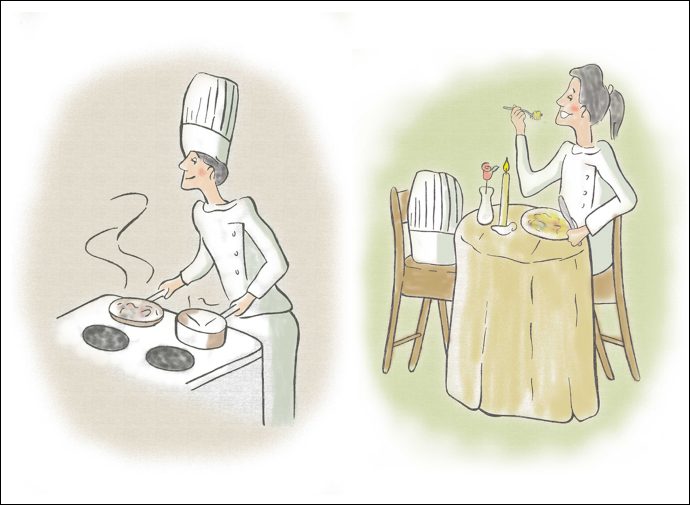There is something about going home at the end of the day or giving over a quiet Sunday afternoon to cooking- smashing the garlic, chopping an onion, getting all those good cooking smells going, stirring and tasting mindfully and then adjusting the seasonings-that makes us feel creative. It is a comforting form of relaxation-something that’s needed in our busy lives…
Judith Jones, Cooking for One
Although I’m a professional chef, the topic I am most frequently asked about does not concern a fine point of technique or an arcane culinary secret. It’s some version of the question, “How can I get started cooking for myself?”
Maybe you want to introduce something new or you already enjoy the nurturance and well-being that can come from a meal prepared at home and enjoyed in solitude. Perhaps health issues have made it a necessity to focus on what goes into the food you eat on a daily basis. Maybe you are adjusting to living alone after years with a partner or children in the house. Maybe like Joe Yonan, food editor of The Washington Post, you need to work your way past being “hangry” (hungry plus angry) at the end of a long bad day at work. For whatever the reason, many of us find ourselves alone in the kitchen.
Dinner alone is one of life’s pleasures. Certainly cooking for oneself reveals man at his weirdest. People lie when you ask them what they eat when they are alone. A salad, they tell you. But when you persist, they confess to peanut butter and bacon sandwiches deep fried and eaten with hot sauce or spaghetti with butter and grape jam.
Laurie Colwin, Home Cooking
The best way to begin is with a vision of you in the kitchen. You need to be able to picture yourself cooking and enjoying the process in a clean and well-organized space. Don’t think each dinner needs to be “balanced”; there is plenty of room for eccentric meals. Think of a balanced day or a balanced week; keep the bigger picture in mind. Don’t forget that there is creativity and opportunity that come when you have only yourself to please.
It is the privilege of loneliness; in privacy one may do as one chooses.
Virginia Woolf, Mrs. Dalloway
Think about what to have in your freezer, how to stock your refrigerator and cupboards, and what your own best arsenal of tools may be, given what you will want to cook. Of course your lists will depend on your personal style, your likes and dislikes, but having some basics can give you confidence and get you engaged in the process. Trust me, the hardest part is getting started. Although I am usually asked for recipes, what most people really need are some strategies. Here are a few.
- Don’t think of each meal as an isolated incident but as part of an ongoing process. What can make being alone in the kitchen too time consuming, too expensive and wasteful is when you need to begin from ground zero every time you want to cook. Rather than thinking of recipes, think of ingredients as building blocks that you can use in different combinations and permutations.
- Look for inspiration from others. The blog Kitchn has a regular feature called Expert Essentials. They ask a fascinating array of chefs, food writers, poets, artists and food artisans for their 5 essentials for the home cook. The essays are alternately inspiring, instructive, practical, and funny.
- Let’s face it; the grocery store is against the solo cook. Economy packaging almost guarantees that you will either have to eat the same thing, day after day, or wind up with limp ingredients that you end up throwing out. Shop at fresh fish and butcher counters where you can buy small amounts of any item. This may seem more expensive but it isn’t when you consider the amount of food that gets wasted when you purchase fresh ingredients in bulk.
- Start thinking about the ubiquitous salad bar found in many grocery stores as a source for a large variety of fresh vegetables, already cut up and ready to go, that you can use beyond salads: for roasting, stir fries, or stews. You can get some variety on the table, fast, with no waste.
- Mis en place. I try to always have some peeled cloves of garlic, a minced onion and some picked and washed parsley and cilantro in the refrigerator. This way the first step is already accomplished when I start to cook and I don’t skip the aromatics when I’m in a hurry.
- Think about equipment. If you reduce the size of a recipe you often also need to adjust the size of pan used in preparing that recipe. Collect the right sized storage containers so that you can freeze individual servings of ingredients for later use in a wide variety of contexts.
- Create a well-stocked pantry. Nancy Silverton wrote a great book on this topic, A Twist of the Wrist, where she fashions delicious and sophisticated meals with specialty ingredients primarily from jars, cans, bags and boxes.
- Think about what ingredients to have on hand in your refrigerator and freezer. Judith Jones, in her book The Pleasure of Cooking for One, gives you her lists. She also provides recipes for the solo diner with “second round” ideas so that one dish leads creatively to another rather than just ending up as a re-heat of leftovers.
- Explore writers whose recipes are easily scaled for one. Heidi Swanson’s recipes on her 101 Cookbooks blog and in her book Super Natural Cooking focus on whole and natural ingredients in recipes that are extremely flexible in terms of quantity.
- Sometimes what it takes to warm up your kitchen, to get it stocked up and ready, is to cook with a friend or to invite a friend for dinner.
Dining Alone: A New Idea Pops Up
I noticed that in our society, there is actually no room for being alone in public spaces. In today’s hyperconnected world, Eenmaal gives its clients the rare opportunity to turn down the volume and focus on themselves before modern life takes over again.
Marina Van Groot
We usually think of dinner as inviting conversation, as a time for sharing hospitality and companionship with friends, family, or colleagues. This will always be true. However, why should there be a stigma attached to dining alone? Ironically I’ve noticed that friends who are very comfortable traveling by themselves often find it hard to make a reservation for one at a restaurant. Why isn’t public space created to enjoy solitude and thoughtful contemplation of a meal? There is a pop up restaurant in Amsterdam determined to do just that, to break the taboo of eating alone in a public space.
Eenmaal was specifically created for the solo diner. Two Dutch design firms, Van Goor and Vandejong, conceived of the idea. The pop up restaurant sets up in empty storefronts that have large front windows and ten tables set for one. There is minimal décor and no Wi-Fi; customers are asked to turn off their smart phones. The menu leans heavily on organic and locally sourced ingredients. Four courses with drinks come to around $50.00. You can follow Eenmaal on their website to find out where they will set up next. The adventure has been so successful there are plans to try the concept in New York, London and Berlin. If you have the opportunity to go, make a reservation; all “pops” are completely sold out.

